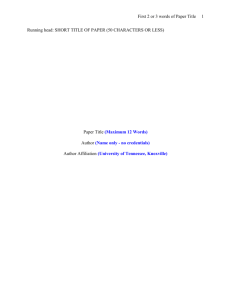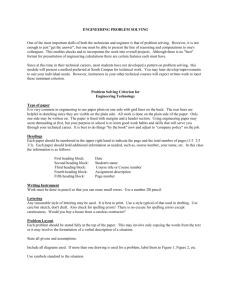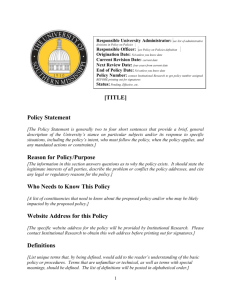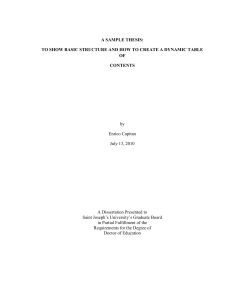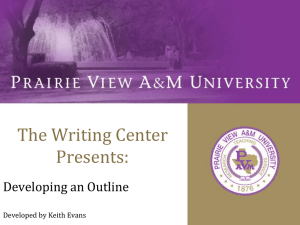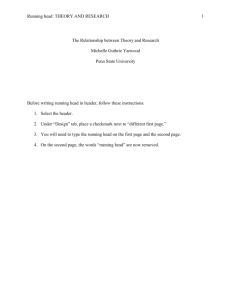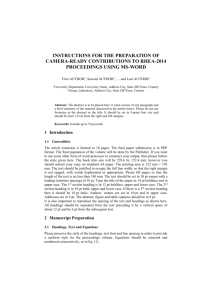paper guidelines
advertisement
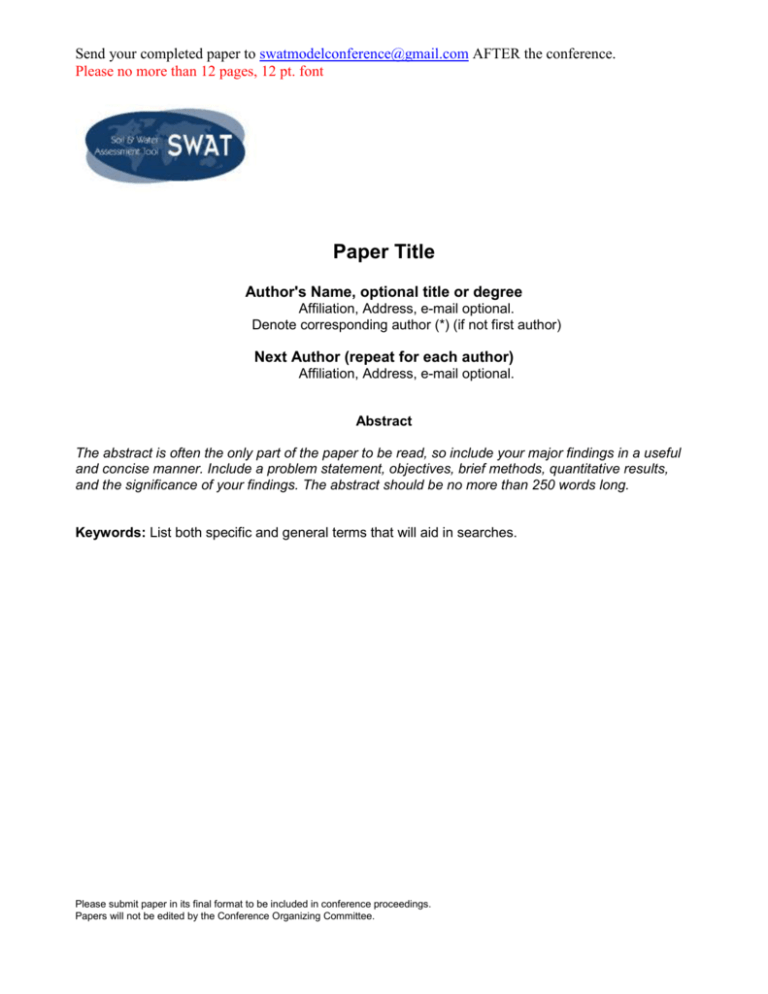
Send your completed paper to swatmodelconference@gmail.com AFTER the conference. Please no more than 12 pages, 12 pt. font Paper Title Author's Name, optional title or degree Affiliation, Address, e-mail optional. Denote corresponding author (*) (if not first author) Next Author (repeat for each author) Affiliation, Address, e-mail optional. Abstract The abstract is often the only part of the paper to be read, so include your major findings in a useful and concise manner. Include a problem statement, objectives, brief methods, quantitative results, and the significance of your findings. The abstract should be no more than 250 words long. Keywords: List both specific and general terms that will aid in searches. Please submit paper in its final format to be included in conference proceedings. Papers will not be edited by the Conference Organizing Committee. Introduction This section automatically starts a new page. Put your figures and tables where you would like them, generally after their first mention. Cite each of your tables, figures, and references in the text, either parenthetically (Author et al., 1998) or as part of a sentence, e.g., Bookauthor (1993) stated that…. Be sure to have someone proofread your paper. It will not be proofread by Conference Organizers. First-Level Headings Beyond Introduction Use the Heading 1 Style Type any combination of Heading 1, Heading 2, text and equations in the Normal Style, figures, tables, captions, and lists. Secondary Headings For second-level headings, type in your words, select them, and pick out the Heading 2 Style from the pull-down Styles menu. If necessary, use Heading 3, etc., for lower-level headings. How to Handle Graphics--This is in Heading 2 Style Put your graphics into the Word document. Color figures will show color in the web version but the paper version will be in black and white. Please test your color figures to be sure they are also legible in black and white. About Tables Table 1. Use the Table Caption Style above each table. Material in the table uses the Use standard Word table Table Contents Style. commands. Use only solid lines, with no diagonals or broken lines. About Lists If you like you may use the List Bullet or List Number Styles for your lists. The paragraph above the list is in the List Start Style. This is typically a phrase such as "We found that…" used to introduce the list. 2 This is an item in a bullet list. Use bullets unless numbering is necessary. This is a second item. Here is a numbered list: 1. This is number one. 2. This is number two. Conclusion Every paper must have a Conclusion section to restate the major findings and suggest further research. It is the last main heading before References. Type any combination of Normal text, Heading 2, equations, figures, tables, captions, and lists. Acknowledgements Acknowledgements, if any, are placed here under a Heading 2. References – Please do not use hyperlinks-Compose your reference entries following the examples below: Journal article Anderson, G. T., C. V. Renard, L. M. Strein, E. C. Cayo, and M. M. Mervin. 1998. A new technique for rapid deployment of rollover protective structures. Applied Eng. in Agric. 23(2): 34-42. Waladi, W., B. Partek, and J. Manoosh. 1999. Regulating ammonia concentration in swine housing: Part II. Application examples. Trans. ASAE 43(4): 540-547. Book Allen, J. S. 1988. Agricultural Engineering Applications. New York, N.Y.: John Wiley and Sons. Coombs, T. R., and F. C. Watson. 1997. Computational Fluid Dynamics. 3rd ed. Wageningen, The Netherlands: Elsevier Science. Part of a Book ASAE Standards, 36th ed. 1989. S352.1: Moisture measurement -- Grain and seeds. St. Joseph, Mich.: ASABE. Havemeyer, T. F. 1995. Statistical methods. In Practical Programming Applications, 223-227. Holland, Mich.: Overstreet Technical Publications. Bulletin or Report CDC. 2000. Infection vectors for E. coli and intervention strategies. CDC Reference No. 9923. Atlanta, Ga.: Centers for Disease Control and Prevention. 3 Jesperson, D. 1995. United States fruit and vegetable harvest projections: 1996. USDA-1007. Washington, D.C.: GPO. Published Paper Anthony, W. S. 1998. Performance characteristics of cotton ginning machinery. ASAE Paper No. 981010. St. Joseph, Mich.: ASABE. Miller, F. R., and R. A. Creelman. 1980. Sorghum: A new fuel. In Proc. 12th International Alternative Fuels Research Conf., 219-232. H. D. Londen and W. Wilkinson, eds. Wageningen, The Netherlands: Elsevier Science. Dissertation or Thesis Campbell, M. D. 1991. The lower limit of soil water potential for potato growth. Unpublished PhD diss. Pullman, Wash.: Washington State University, Department of Agricultural Engineering. Lawrence, D. J. 1992. Effect of tillage and crop rotation on soil nitrate and moisture. MS thesis. Ames, Iowa: Iowa State University, Department of Soil Science. Software SAS. 1990. SAS User's Guide: Statistics. Ver. 6a. Cary, N.C.: SAS Institute, Inc. SPSS. 2000. SigmaPlot for Windows. Ver. 3.2. Chicago, Ill.: SPSS, Inc. Online Source USDA. 1999. Wheat Production in the Upper Plains: 1998-1999. National Agricultural Statistics Database. Washington, D.C.: USDA National Agricultural Statistics Service. Available at: www.nass.usda.gov. Accessed 23 April 2000. NSC. 2001. Injury Facts Online. Itasca, Ill.: National Safety Council. Available at: www.nsc.org. Accessed 17 December 2001. Patent Moulton, R. K. 1992. Method for on-site cleaning of contaminant filters in livestock housing facilities. U.S. Patent No. 32455986. Richarde, J. 1983. Process for protecting a fluid product and installations for the realization of that process. French Patent No. 2513087 (in French). Appendix or Nomenclature This optional section can include lists of nomenclature or abbreviations, reference data, or tables that are too long to include in the body of the article. 4



